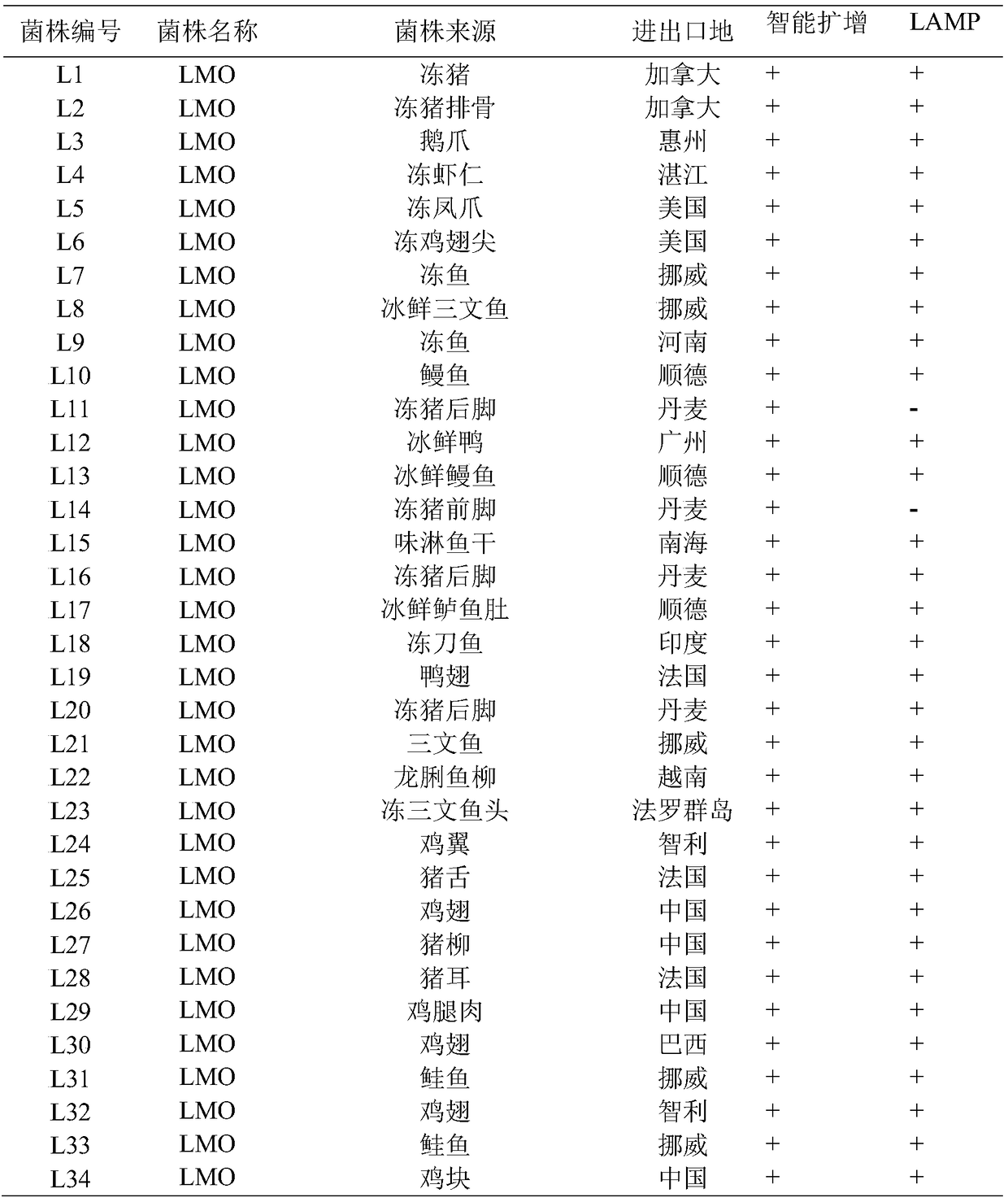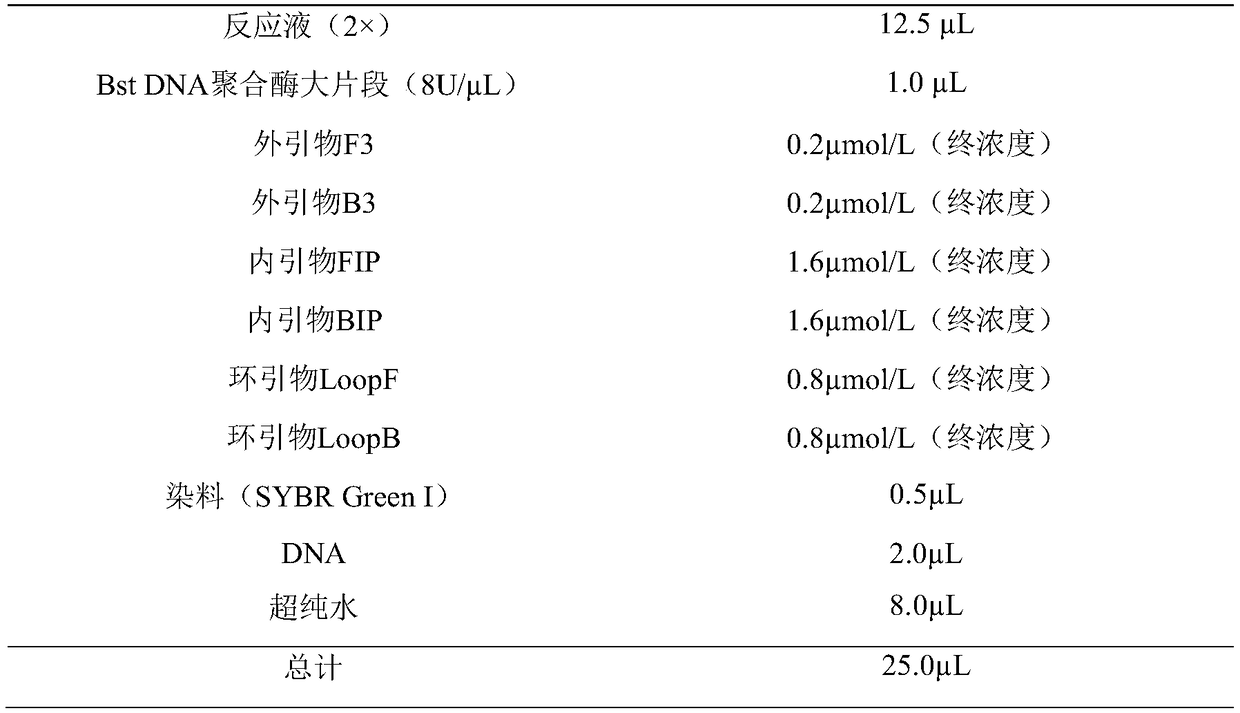Primer group, kit and method for detecting listeria monocytogenes on basis of intelligent isothermal amplification technology
A technology of Listeria monocytogenes and constant temperature amplification is applied in the field of primer sets for detecting Listeria monocytogenes, which can solve the problem of shortening the identification time of Listeria monocytogenes, reducing the difficulty and cost of identification technology, and the detection cycle. It can overcome the problems of gene polymorphism detection, accurate gene polymorphism and short detection time.
- Summary
- Abstract
- Description
- Claims
- Application Information
AI Technical Summary
Problems solved by technology
Method used
Image
Examples
Embodiment 1
[0034] Example 1 Establishment of Listeria monocytogenes intelligent constant temperature amplification detection kit
[0035]Intelligent constant temperature amplification detection kit for Listeria monocytogenes, including intelligent constant temperature amplification primer set, intelligent constant temperature amplification reaction solution, Bst DNA polymerase, mismatch binding protein Tap Muts, positive control and negative control, fluorescence Reagent.
[0036] (1) Design of intelligent thermostatic amplification primers: The primers were designed with the hlyA gene of Listeria monocytogenes as the target gene. The primer sequences are listed in Table 1.
[0037] Table 1 Primer sequence list
[0038] Primer name
Primer sequence (5'-3')
FP
TTTATATATATATAAATCTCAGGTCATGTAGG (SEQ ID NO: 1)
TP
TAGGACTGAACAATTACGGCTTTGAAGGAA (SEQ ID NO: 2)
BP
ATATCATCAAAAAT (SEQ ID NO: 3)
OP1
GGCGTACGCGGGAAATCT (SEQ ID NO: 4)
...
Embodiment 2
[0042] Embodiment 2 establishes the Listeria monocytogenes detection method:
[0043] The method utilizing the kit of embodiment 1 to detect Listeria monocytogenes may further comprise the steps:
[0044] (1) Extraction of DNA from the sample to be tested: extract DNA from the sample using a bacterial DNA extraction kit;
[0045] (2) Isothermal gene amplification reaction: 25 μL reaction system contains 1.6 μmol / L of TP and EP primers, 0.8 μmol / L of BP primers, 0.5 μmol / L of OP1 and OP2 primers, 0.5 mmol / L of dNTPs, and 0.6 μmol / L of betaine mol / L, (NH4)2SO4mmol / L, MgCl2 2.5mmol / L, KCl 10mmol / L, MgSO42mmol / L, Green I 0.5μL, Tris-HCl with pH 8.8 20mmol / L, 0.2% 20. 6U Bst DNA polymerase, 1μg Tap Muts, 1μL DNA template, make up to 25μL with deionized water; set positive control and negative control; mix the prepared PCR tube and centrifuge, and react at 60-65℃ 40min.
[0046] (3) Judgment of results: place the reaction tube in the nucleic acid amplification instrument for r...
Embodiment 3
[0047] Embodiment 3 specificity experiment
[0048] Using the method of Example 2 to separate and purify Listeria monocytogenes ATCC19115 / 413, Salmonella ATCC14028, Staphylococcus aureus ATCC6538, Escherichia coli O157ATCC43889, Enterobacter sakazakii ATCC29544, Pseudomonas aeruginosa ATCC9027, Escherichia coli ATCC25922, Escherichia coli CMCC44102, Enterobacter sakazakii ATCC12868, Vibrio parahaemolyticus ATCC17802, Vibrio vulnificus ATCC27562, Staphylococcus aureus CMCC26003, Shigella baumannii CMCC51346, Shigella sonnei NICP51334, Proteus vulgaris NICPB490059, The DNA of Proteus mirabilis HB7131, Klebsiella CMCC (B) 46117, and Micrococcus luteus CMCC28001 were detected.
[0049] The identification results showed that the DNA of Listeria monocytogenes ATCC19115 / 413 was amplified normally, and the DNA of other bacteria and the negative control were not amplified (Table 2). showed good specificity.
PUM
 Login to View More
Login to View More Abstract
Description
Claims
Application Information
 Login to View More
Login to View More - R&D
- Intellectual Property
- Life Sciences
- Materials
- Tech Scout
- Unparalleled Data Quality
- Higher Quality Content
- 60% Fewer Hallucinations
Browse by: Latest US Patents, China's latest patents, Technical Efficacy Thesaurus, Application Domain, Technology Topic, Popular Technical Reports.
© 2025 PatSnap. All rights reserved.Legal|Privacy policy|Modern Slavery Act Transparency Statement|Sitemap|About US| Contact US: help@patsnap.com


